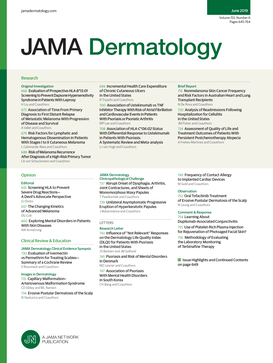Key Points
- Question Is antihypertensive drug use associated with diagnoses of eczematous dermatitis among older adults?
- Findings This cohort study using a population-based primary care cohort of 1.5 million older adults found that antihypertensive drug use was associated with a 29% increase in the rate of eczematous dermatitis diagnoses. The hazard rate was highest for diuretic drugs and calcium channel blockers and lowest for angiotensin-converting enzyme inhibitors and β-blockers.
- Meaning These findings indicate that physicians should consider antihypertensive treatment as part of the differential diagnoses for older patients presenting with eczematous dermatitis.
Abstract
Importance Rates of physician-diagnosed eczema have been increasing among older adults, but little is known regarding the pathophysiologic processes and best treatments in this subgroup. Preliminary data suggest that medications—antihypertensive medications in particular—may contribute to eczematous dermatitis; however, there are limited population-based data on the proportion of eczematous dermatitis diagnoses among older adults that may be attributed to antihypertensive drugs.
Objectives To determine whether antihypertensive drug use is associated with eczematous dermatitis in older adults.
Design, Settings, and Participants This was a longitudinal cohort study of a population-based sample of individuals 60 years and older without a diagnosis of eczematous dermatitis at baseline. It was conducted at primary care practices participating in The Health Improvement Network in the United Kingdom from January 1, 1994, to January 1, 2015. Data analyses were performed from January 6, 2020, to February 6, 2024.
Exposure Exposure date by first prescription for an antihypertensive drug within each drug class.
Main outcome measures Newly active eczematous dermatitis was based on the first date for 1 of the 5 most common eczema codes used in a previously validated algorithm.
Results Among the total study sample of 1 561 358 older adults (mean [SD] age, 67 [9] years; 54% female), the overall prevalence of eczematous dermatitis was 6.7% during a median (IQR) follow-up duration of 6 (3-11) years. Eczematous dermatitis incidence was higher among participants receiving antihypertensive drugs than those who did not (12 vs 9 of 1000 person-years of follow-up). Adjusted Cox proportional hazard models found that participants who received any antihypertensive drugs had a 29% increased hazard rate of any eczematous dermatitis (hazard ratio [HR], 1.29; 95% CI, 1.26-1.31). When assessing each antihypertensive drug class individually, the largest effect size was observed for diuretic drugs (HR, 1.21; 95% CI, 1.19-1.24) and calcium channel blockers (HR, 1.16; 95% CI, 1.14-1.18), and the smallest effect sizes were for angiotensin-converting enzyme inhibitors (HR, 1.02; 95% CI, 1.00-1.04) and β-blockers (HR, 1.04; 95% CI, 1.02-1.06).
Conclusions and Relevance This cohort study found that antihypertensive drugs were associated with a small increased rate of eczematous dermatitis, with effect sizes largest for calcium channel blockers and diuretic drugs, and smallest for angiotensin-converting enzyme inhibitors and β-blockers. Although additional research is needed to understand the mechanisms underlying the association, these data could be helpful to clinicians to guide management when a patient presents with eczematous dermatitis in older age.


No comments:
Post a Comment